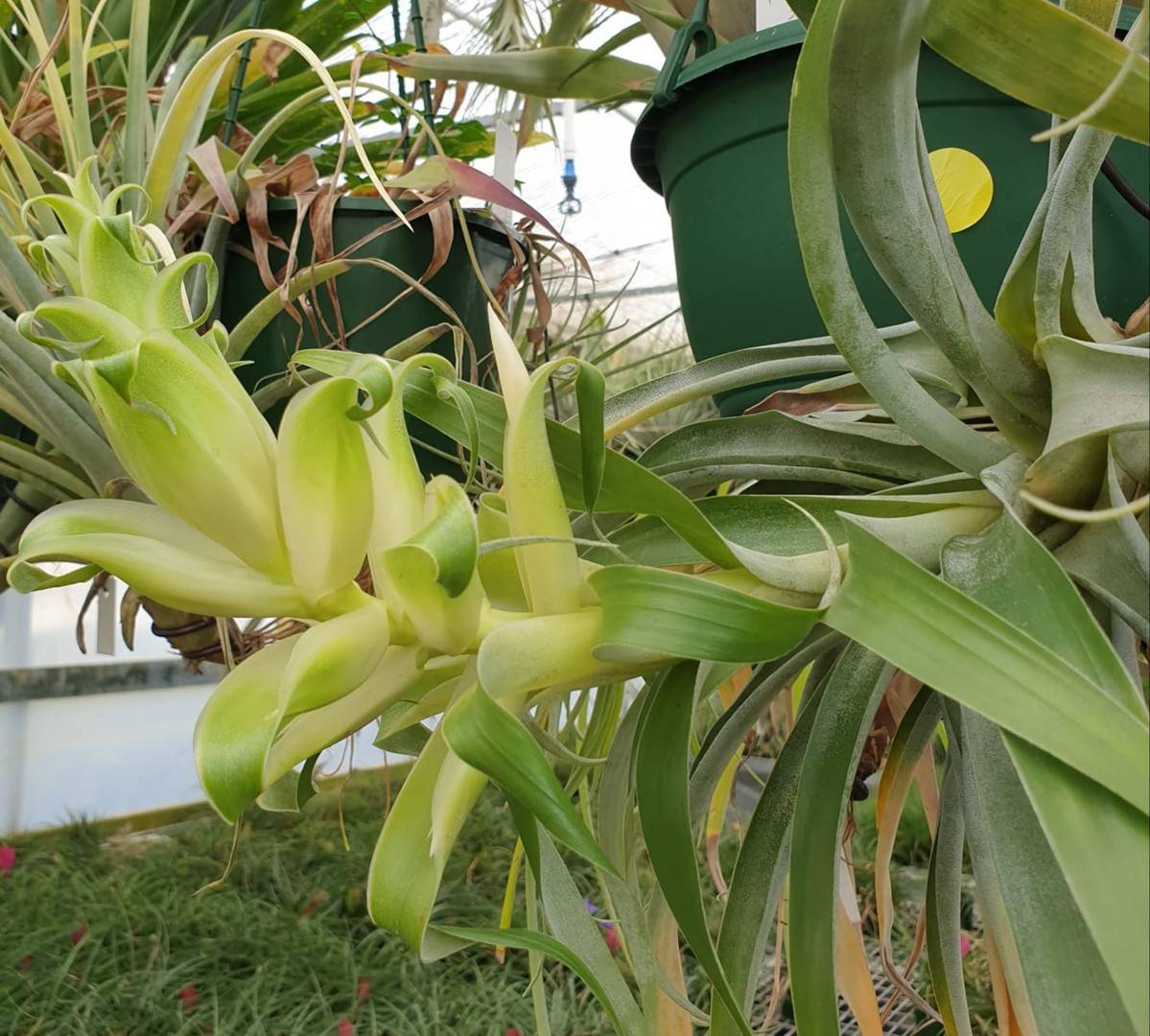
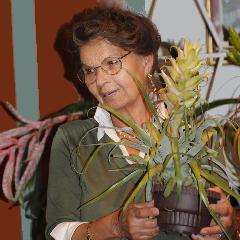
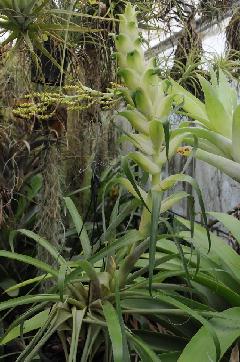
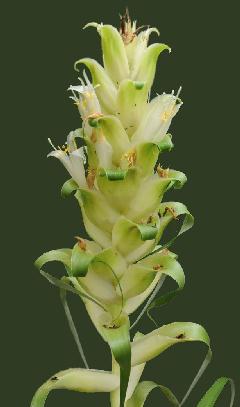
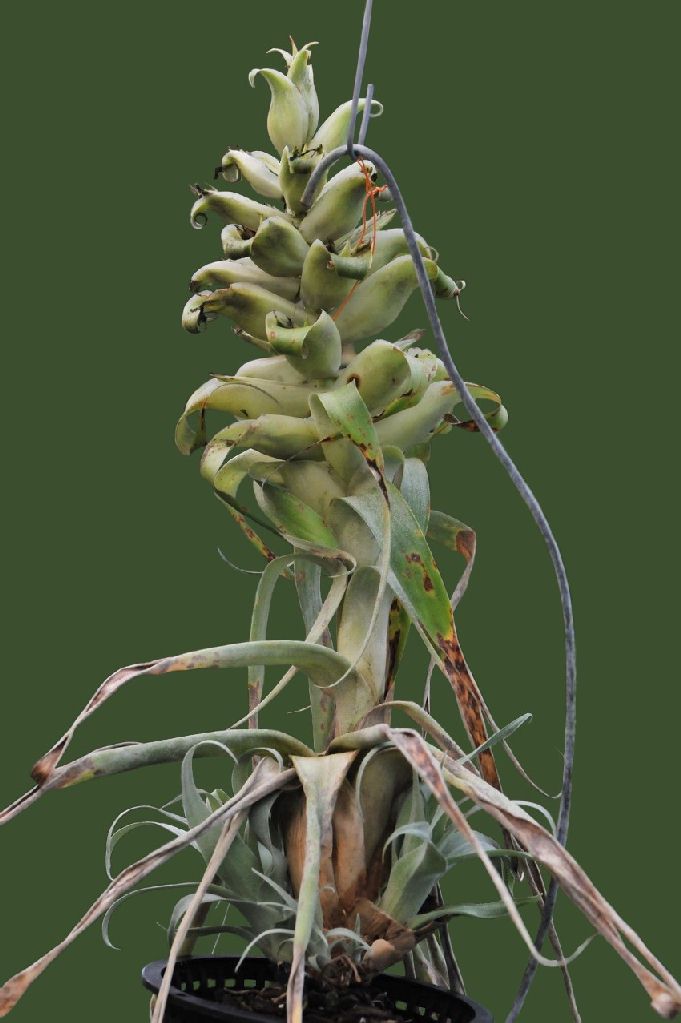
Peter Tristram 02/13 ... "Not only does T. tillii pup without seed it also does with – good news in all respects. The first pup from the other one I posted a couple of years ago has bloomed and hopefully it will also pup. I might get game to whack 1 outside like Lydia’s plant pictured on the dvd – full German sun! I just hope most of the other Mexican treasures, from Lydia in particular, also pup as much of the seed harvested so far hasn’t germinated."
Len Colgan 02/13 ... "Of remote interest concerning this plant, T. tillii.
Many years ago, Renate Ehlers confided that, for personal reasons, her two favourite tillandsias are, of course, T. ehlersiana and T. klausii. Because she does not have university qualifications, virtually all of her 100+ new tillandsia species descriptions contain a Latin diagnosis supplied by Walter Till. In appreciation, in the early 1990s, she wanted to name her third most favourite tillandsia in his honour as T. tillii. However, Walter declined as he preferred another plant that was also being described by Renate, which is the plant shown by Pete. A few years later, the "rejected" plant was named by Renate as T. salmonea due to its salmon-coloured bracts.
Renate has always thought that Walter made the wrong decision. What do you think?
A T. laui Matuda, cui versimiliter affinis, foliis pallide viridibus adpresse lepiodotis cum limbis brevioribus, spicis magis patentibus, axi inflorescentiae visibili, spicis angustioribus solum circa 2-floribus, bracteis primariis longe ovalibus inflatis vinese-punctatis, bracteis florigeris sepalis brevioribus, sepalis multo longioribus et breviter connatis et petalis elliptice-acuminatis nec spathulatis differt.
Typus. Mexico, Estdo. Jalisco: ad australem urbis Puerto Vallarta in Sierra el Tuito, ca. 1600 m.s.m., epiphytica in pinus sp. et arboribus caducifoliis, 16. 3. 1990, leg. R. & K. Ehlers EM 901608 (holotypus et isotypi: WU). Adhuc nota solum loco classico.
Plant stemless, flowering 15-60 cm high, 45 cm in diameter.
Leaves numerous, forming an erect, subspreading infundibuliform rosette with subbulbous base.
Leaf sheaths erect, 13-16 cm long, 8 cm wide, elliptic, distinct, subinflated, somewhat nerved, proximally 5 cm light brown then violet-brown, adaxially less, abaxially more, finely appressed brown lepidote, above the sheath 4 cm wide.
Leaf blades up to 28 cm long, narrowly triangular, tapering to a short, sub filiform, often-twisted apex, more or less spreading, nerved, moss green with violet spots especially toward the tips; ad axially finely and abaxially densely appressed gray lepidote.
Scape 10-12 cm long, erect, stout 1.5 cm in diameter,
Scape bracts densely imbricate, foliaceous, the sheaths concealing the scape, the blades to 20 cm long and recurved.
Inflorescence erect, to 30 cm high, 18 cm wide, cylindric, bipinnately composed of more than 20 polystichously arranged spikes spreading 60-80 degrees from the main axis, internodes 1.5 to 1 cm long.
Lower Primary bracts inflated sheaths longer than the spikes, the apical ones as long as the spikes, enfolding the broad side of the spike, ovate, to 6.5 cm long and 5.5 cm wide, light green, translucent with purple-red spots, strongly nerved, proximal half dark punctulate lepidote, distal half gray lepidote, 2-2.5 cm wide above the sheath. The blades of the lower primary bracts to 18 cm long, narrowly triangular, acuminate, reflexed; Upper Primary bracts becoming gradually shorter and more or less acute, light green densely lepidote.
Axis of inflorescence very stout, visible.
Spikes dorsiventrally compressed with the adaxial side flat, the peduncle 6 mm long, 10 mm wide, to 5.5 cm long, 2.5 cm wide, elliptic, two-flowered with an additional vestigial flower; stipe to 1.2 cm long, the basic spike reduced to 1 flower.
Flowers odorless, subsessile, 6.5 cm long.
Floral bracts shorter than the sepals and densely enfolding them but leaving their apices visible, to 3.7 cm long, 2.3 cm wide, elliptic, acute, with sub hyaline margins, nerved, appearing glabrous but minutely punctulate lepidote, alate carinate, whitish green, apically faintly red spotted.
Sepals to 4.4 cm long and 1.3 cm wide, narrowly elliptic, acute with curved apex, the posterior two connate with each other for 5-6 mm and to the anterior for 3-4 mm, all towards the base with thickened keels, membranaceous, nerved, whitish green.
Petals 5-8 cm long to 1.3 cm wide, narrowly elliptic, narrowly acute, firm, nerved, porcelain white, forming an erect tube with revolute tips, corolla throat from nearly closed around the filaments to wide open.
Stamens exserted.
Filaments to 4.5 cm long, equal in length, flat, 1.3 mm wide tapering to 1 mm at apex and base, basal third plicate and twisted.
Anthers to 1.3 cm long, 1.1 mm wide, linear, subbasifixed at the sagittate base, egg yellow, pollen yellow.
Style longer than the stamens, to 5.2 cm long, 1.5 mm wide, white;
stigma 1.5 x 1.5 mm with erect, single-twist lobes, white, (Type II of Brown & Gilmartin 1984).
Ovary 8 mm long, 5 mm in diameter at base, conical, light green.
The L.B. Smith key (Smith & Downs 1977) did not provide any correlation. The plant seems to be related to T. laui Matuda but differs in the following characteristics:
Leaves light green, appressed lepidote, shorter blades.
Inflorescence branches spread to 80 degrees, axis visible, spikes narrower, 2-flowered.
Primary bracts long-ovate, inflated, red-spotted.
Floral bracts shorter than the sepals.
Sepals longer and short connate.
Petals elliptic-acute, not spatulate.
We name this new species in honor of our friend, Dr. Walter Till, of the Botanical Institute, University of Vienna, Austria, who is known and respected for his studies of the genus Tillandsia and especially for his dissertation on the subgenus Diaphoranthema.